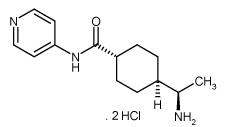
Chemical Structure
Y-27632 dihydrochloride
M1817
CAS Number129830-38-2
Product group Chemicals
Estimated Purity0.9972
Molecular Weight320.26
Overview
- SupplierAbMole BioScience
- Product NameY-27632 dihydrochloride
- Delivery Days Customer9
- CAS Number129830-38-2
- CertificationResearch Use Only
- Estimated Purity0.9972
- Molecular FormulaC14H21N3O.2HCl
- Molecular Weight320.26
- Scientific DescriptionY-27632 is a potent, selective inhibitor of Rho-associated protein kinases (ROCK) with IC50 values of 140-220 nM for ROCK1 and ROCK2. Y-27632 inhibited the kinase activity of both ROCK-I and ROCK-II in vitro, and this inhibition was reversed by ATP in a competitive manner. The ROCK family of Rho-associated serine-threonine protein kinases is known to play an important role in Rho-mediated cell adhesion and smooth muscle contraction. It also inhibits PRK2 with an IC50 value of 600 nM. One-hour treatment with 10 µM Y-27632 blocks apoptosis of dissociated cultured human embryonic stem cells, increasing cloning efficiency by 25% and sustaining survival up to 30 passages. Y-27632 was found to increases human embryonic stem cell (hESC) survival. In addition, Y-27632 inhibited LPA-induced entosis.
- SMILESCl.Cl.CC(N)C1CCC(CC1)C(=O)NC2=CC=NC=C2
- UNSPSC12352200
References
- Borrelli C, Roberts M, Eletto D, et al. In vivo interaction screening reveals liver-derived constraints to metastasis. Nature. 2024,632(8024):411-418. doi: 10.1038/s41586-024-07715-3Read this paper
- Rosendahl Huber A, Pleguezuelos-Manzano C, Puschhof J, et al. Improved detection of colibactin-induced mutations by genotoxic E. coli in organoids and colorectal cancer. Cancer Cell. 2024,42(3):487-496.e6. doi: 10.1016/j.ccell.2024.02.009Read this paper
- Hendriks D, Pagliaro A, Andreatta F, et al. Human fetal brain self-organizes into long-term expanding organoids. Cell. 2024,187(3):712-732.e38. doi: 10.1016/j.cell.2023.12.012Read this paper
- Sharma G, Sharma A, Kim I, et al. A dietary commensal microbe enhances antitumor immunity by activating tumor macrophages to sequester iron. Nat Immunol. 2024,25(5):790-801. doi: 10.1038/s41590-024-01816-xRead this paper
- Bannier-Hélaouët M, Korving J, Ma Z, et al. Human conjunctiva organoids to study ocular surface homeostasis and disease. Cell Stem Cell. 2024,31(2):227-243.e12. doi: 10.1016/j.stem.2023.12.008Read this paper
- Qiu Y, Stamatatos OT, Hu Q, et al. The unique catalytic properties of PSAT1 mediate metabolic adaptation to glutamine blockade. Nat Metab. 2024,6(8):1529-1548. doi: 10.1038/s42255-024-01104-wRead this paper
- Fan G, Yu B, Tang L, et al. TSPAN8(+) myofibroblastic cancer-associated fibroblasts promote chemoresistance in patients with breast cancer. Sci Transl Med. 2024,16(741):eadj5705. doi: 10.1126/scitranslmed.adj5705Read this paper
- Kim WK, Buckley AJ, Lee DH, et al. Androgen deprivation induces double-null prostate cancer via aberrant nuclear export and ribosomal biogenesis through HGF and Wnt activation. Nat Commun. 2024,15(1):1231. doi: 10.1038/s41467-024-45489-4Read this paper
- Li Y, Jiang M, Aye L, et al. UPP1 promotes lung adenocarcinoma progression through the induction of an immunosuppressive microenvironment. Nat Commun. 2024,15(1):1200. doi: 10.1038/s41467-024-45340-wRead this paper
- Hendriks D, Artegiani B, Margaritis T, et al. Mapping of mitogen and metabolic sensitivity in organoids defines requirements for human hepatocyte growth. Nat Commun. 2024,15(1):4034. doi: 10.1038/s41467-024-48550-4Read this paper


![Y-27632 dihydrochloride [129830-38-2]](https://www.targetmol.com/group3/M00/02/2E/CgoaEGY7K0GEPFOdAAAAAOog8jo262.png)